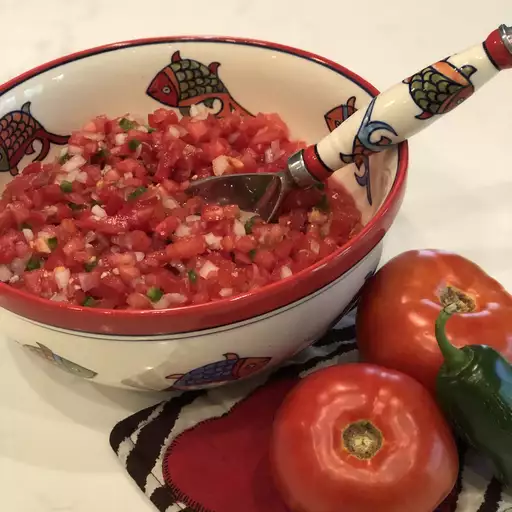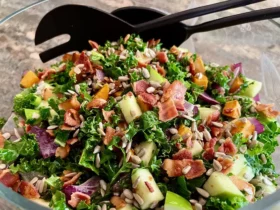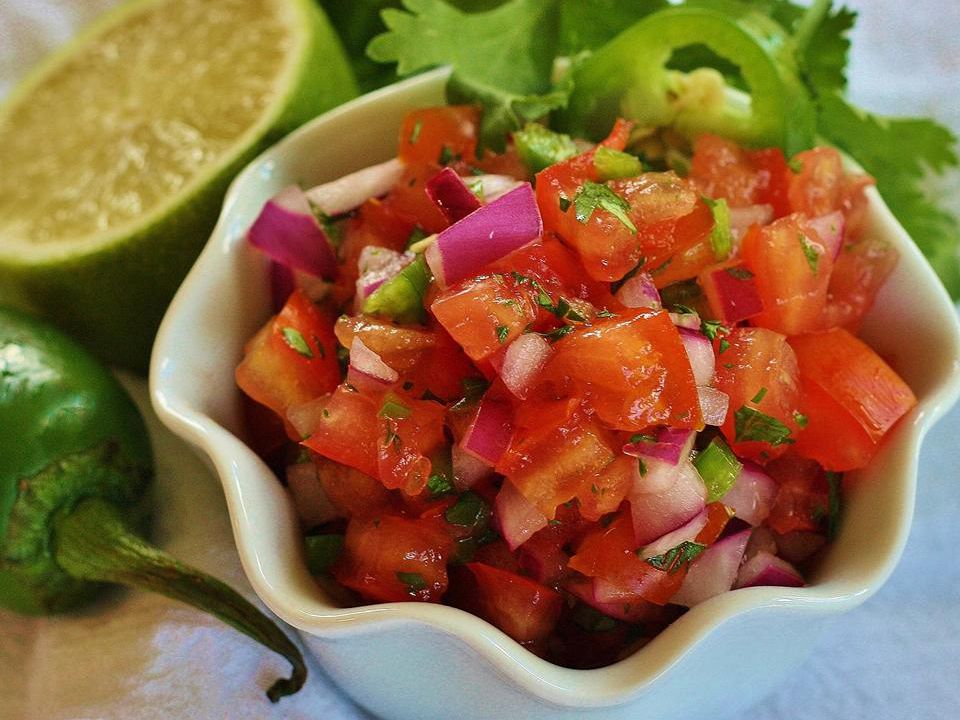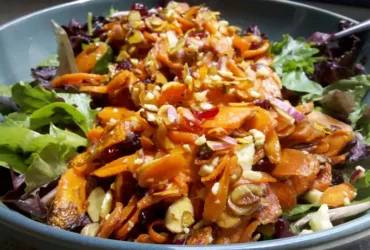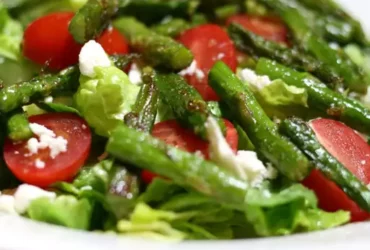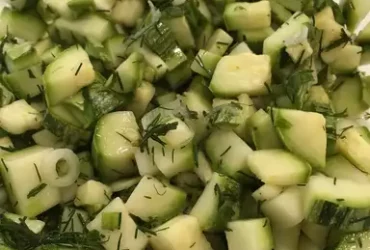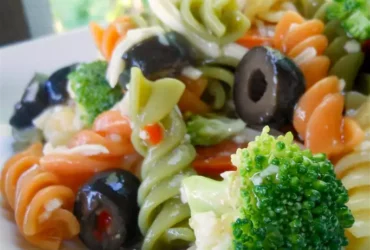Ingredients
Salsa Fresca Essentials
The essential ingredients for a traditional Ex-Girlfriend’s Mom’s Salsa Fresca recipe, also known as Pico de Gallo, are:
- Chop Fresh Tomatoes: The base of the salsa, use about 2 cups of diced fresh tomatoes. You can use any variety, but ripe and flavorful tomatoes work best.
- Roughly Chopped Onions: About 1/2 cup of finely chopped onions adds a punchy flavor and crunchy texture to the salsa.
- Jalapeño Peppers: For an authentic Salsa Fresca taste, add 1-2 diced jalapeños, depending on your desired level of heat. Be sure to seed and chop them finely for a balanced flavor.
- Cilantro: Chopped cilantro leaves about 1/4 cup, adding a fresh herbal aroma and texture to the salsa.
- Garlic: Minced garlic adds depth and richness. Use 2-3 cloves for this recipe, depending on your taste preferences.
Squeeze in some freshly squeezed lime juice (about 1 tablespoon) to balance out the flavors, followed by a sprinkle of salt to bring it all together. Taste and adjust seasoning as needed. Your Salsa Fresca is now ready to be enjoyed!
Fresh tomatoes (preferably Roma or cherry)
The star ingredient of any great Pico de Gallo, or Salsa Fresca, recipe is undoubtedly the fresh tomato. When it comes to selecting tomatoes for this purpose, Roma and cherry tomatoes are often preferred due to their unique characteristics that make them ideal for this dish.
Roma tomatoes, also known as ‘plum’ tomatoes, have a dense, meaty texture that holds up well when diced and mixed with other ingredients. Their low water content also ensures that they won’t release too much liquid during the preparation process, which can result in a salsa that’s more sauce-like than chunky.
On the other hand, cherry tomatoes bring a burst of sweetness and juiciness to the table. They’re small enough to be halved or quartered without being overpowered by larger pieces, making them perfect for adding pops of color and flavor throughout the salsa.
It’s worth noting that heirloom tomatoes can also be used in Pico de Gallo, but they might add a slightly different taste profile due to their varying acidity levels. The more acidic varieties can help balance out the sweetness from the cherry tomatoes, while others might require a bit more lime juice to achieve the desired flavor.
When choosing fresh tomatoes for your Salsa Fresca recipe, be sure to select those that are firm, yet yield slightly to pressure when pressed. This will ensure they’re ripe enough to have the optimal balance of sweetness and acidity without being overripe or mealy.
Finally, if you can’t find Roma or cherry tomatoes, other varieties like beefsteak or grape tomatoes can be used as substitutes. However, keep in mind that their flavor and texture profiles will differ slightly from the preferred options, so some experimentation might be necessary to achieve the perfect balance for your taste buds.
Overall, selecting the right type of fresh tomato is essential to creating a truly authentic Pico de Gallo recipe. With Roma or cherry tomatoes as your base ingredients, you’ll be well on your way to crafting a delicious Salsa Fresca that will transport your taste buds to Mexico’s vibrant culinary scene.
Red onion
The red onion is a crucial ingredient in many recipes, including our Ex-Girlfriend’s Mom’s Salsa Fresca. It adds a pungent flavor and a crunchy texture to the salsa. When selecting a red onion, look for one that has a firm, smooth skin with no signs of sprouting or mold.
The most commonly available types of red onions are the ‘Redwing’ and ‘Texas Grano’. Both have a sweet, mild flavor and a firm texture that holds up well to chopping. The ‘Redwing’ onion is a bit sweeter and has a more vibrant color, while the ‘Texas Grano’ onion is a bit more pungent.
To prepare the red onion for the salsa, peel it using a vegetable peeler or a sharp knife, being careful not to tear the layers. Then, chop the peeled onion into small dice. To remove some of the pungency and bring out the sweetness, soak the chopped onion in cold water for about 30 minutes. After soaking, drain the onions and pat them dry with paper towels before adding them to the salsa.
When chopping the red onion, it’s essential to cut it finely enough so that it blends well into the other ingredients without overpowering the flavors of the tomatoes and cilantro. A good rule of thumb is to chop the onion until it’s almost pureed, but still retains a bit of texture.
The amount of red onion needed for this salsa fresca recipe can be adjusted to your liking, depending on how pungent you prefer your salsa. However, as a general guideline, use about 1/2 cup of chopped red onion per 3 cups of diced tomatoes and 1/4 cup of chopped cilantro.
Remember to handle the chopped onions with clean hands or utensils, as any bacteria on them can contaminate the entire salsa. Also, be sure to store the prepared salsa in an airtight container in the refrigerator to prevent spoilage and ensure food safety.
Cilantro leaves (also known as coriander)
Cilantro leaves, also known as coriander, are a crucial ingredient in many Mexican and Latin American dishes, including Ex-Girlfriend’s Mom’s Salsa Fresca recipe.
Here are some key characteristics of cilantro:
- Aroma: Cilantro has a distinct, pungent aroma that is often described as fresh and citrusy. This aroma is due to the presence of aldehydes, specifically (E)-2-decenal.
- Taste: The taste of cilantro can be described as pungent, earthy, and slightly bitter.
- Culinary uses: Cilantro is commonly used as a garnish or mixed with other ingredients in salsas, salads, soups, and sauces. It’s also used to add flavor to dishes like tacos, grilled meats, and vegetables.
In the context of Ex-Girlfriend’s Mom’s Salsa Fresca recipe, cilantro is added towards the end of preparation to preserve its fresh flavor and aroma.
The key benefits of using fresh cilantro include:
- Flavor: Fresh cilantro has a more vibrant and intense flavor compared to dried or frozen cilantro.
- Aroma: The aroma of fresh cilantro is more pronounced and appealing, making it ideal for garnishing dishes.
In addition to its use in salsas and other Mexican dishes, cilantro has also been used in traditional medicine for centuries. It’s believed to have antiseptic and anti-inflammatory properties, although these claims are not supported by scientific evidence.
Some tips for working with cilantro include:
- Use fresh cilantro within a day or two of purchase: Fresh cilantro can spoil quickly if not used promptly. Be sure to store it in a sealed container and keep it refrigerated at 40°F (4°C) or below.
- Choose curly-leafed cilantro over flat-leafed cilantro: Curly-leafed cilantro is generally considered to have better flavor and aroma than flat-leafed cilantro.
Overall, cilantro is a versatile and flavorful herb that adds depth and complexity to many dishes. Its unique aroma and taste make it an essential ingredient in Ex-Girlfriend’s Mom’s Salsa Fresca recipe and other traditional Mexican and Latin American dishes.
Jalapeño pepper
The jalapeño pepper is a staple ingredient in many Mexican dishes, including Pico de Gallo, also known as Salsa Fresca. This type of pepper adds heat and flavor to the recipe.
Jalapeños are a variety of hot peppers that belong to the Capsicum family. They are native to Mexico and Central America, where they have been cultivated for centuries. The name “jalapeño” comes from the Nahuatl language, in which it is written as “xalapen,” meaning “from Xalapa.” However, it’s worth noting that the pepper did not actually originate from the city of Xalapa.
The jalapeño pepper has a number of characteristics that make it an ideal ingredient for Pico de Gallo. It is relatively small in size, with most varieties growing to be around 2-3 inches (5-7.5 cm) long and about 0.5-1 inch (1.25-2.5 cm) wide. The pepper has a glossy, smooth skin that ranges in color from green to red.
The flavor of the jalapeño pepper is hot, spicy, and slightly sweet. It has a moderate to intense heat level, with an Scoville heat unit rating of 2,500-8,00 For comparison, a bell pepper has a rating of zero, while a habanero pepper has a rating of 100,000-350,000.
The main compounds responsible for the flavor and heat of the jalapeño pepper are capsaicinoids, particularly capsaicin and dihydrocapsaicin. These compounds are concentrated in the seeds and white membranes of the pepper, which is why they can be so hot.
To use a jalapeño pepper in Pico de Gallo, you will typically want to chop or dice it finely and add it to the other ingredients. The amount of heat you desire will depend on your personal preferences and the type of recipe you are making. If you prefer a milder salsa, you can start with just one or two peppers and adjust to taste.
Here’s a list of some common varieties of jalapeño peppers:
- Cascabel: This variety is known for its rounded shape and sweet flavor.
- Fresno: This pepper is smaller than the typical jalapeño, with a more intense heat level.
- Guajillo: This pepper has a distinctive, fruity flavor and a relatively low heat level.
- Poblano: While technically not a true jalapeño, this pepper is often used in similar recipes.
Jalapeños are available year-round, although their peak season is typically from May to October. You can find them at most supermarkets and specialty food stores, usually in the produce section or in jars as part of a salsa mix.
Lime juice
The key to making a truly exceptional Pico de Gallo, also known as Salsa Fresca, lies in using only the freshest and highest-quality ingredients.
One of the most crucial components of this recipe is lime juice. Freshly squeezed lime juice adds an unmistakable zing to the salsa, balancing out the flavors and leaving you wanting more.
To get the best results, choose limes that are firm, but not too hard – a slight give when pressed should be sufficient. This will indicate that they have reached optimal ripeness.
Once you’ve selected your limes, it’s essential to extract their juice effectively. The most efficient method is to use a manual or electric juicer, but if neither of these options is available, a simple squeeze between two spoons or using the citrus squeezer can work just as well.
The quality of lime juice greatly impacts the overall flavor and aroma of your Salsa Fresca. Freshly squeezed juice provides a brightness and depth that store-bought alternatives simply cannot replicate.
Some people prefer to add a bit of sugar or honey to balance out the tartness of the lime juice, but using high-quality limes should minimize the need for this extra step.
Of course, it’s worth noting that while fresh lime juice is essential for Salsa Fresca, other ingredients like diced onions, jalapenos, cilantro, and tomatoes are also crucial in achieving a delicious balance of flavors.
But when it comes to making an authentic Pico de Gallo recipe like your ex-girlfriend’s mom taught you, there’s no substitute for using the best quality lime juice possible.
Salt
Salt, a fundamental ingredient in many recipes, including the Ex-Girlfriend’s Mom’s Salsa Fresca (Pico de Gallo), plays a crucial role in enhancing flavors and textures.
Here are some key aspects of salt:
- Types of Salt: There are several types of salt available, each with its unique characteristics. Some common types include:
- Kosher Salt: A coarser-grained salt used for seasoning and preserving. Its large crystals dissolve easily on the tongue, making it ideal for cooking.
- Sea Salt: Harvested from seawater, sea salt is often coarse in texture and has a distinct flavor profile. It’s perfect for adding a touch of the ocean to dishes.
- Table Salt: Refined and processed to be finer and more uniform, table salt is commonly used as a seasoning.
Salt Functions in Recipes:
- Flavor Enhancer: Salt enhances the flavors of ingredients, making them taste better. It balances sweetness, acidity, and bitterness in a dish.
- Tenderizer: Salt helps break down proteins in meat, making it tender and easier to cook. This is especially useful for tougher cuts of beef or pork.
- Texture Modifier: Salt can help regulate the texture of ingredients. For example, salt helps bring out the crunch in crispy vegetables while softening beans and grains.
Amount of Salt to Use:
- In general, use salt sparingly, as it’s easy to overseason a dish. Aim for about 1/4 teaspoon of salt per tablespoon of other ingredients.
- In recipes that require long cooking times, such as braises or stews, you can add more salt towards the end of cooking time to avoid over-seasoning the dish.
When Using Salt in Ex-Girlfriend’s Mom’s Salsa Fresca (Pico de Gallo) Recipe:
- Add a pinch of salt to balance out the flavors and bring out the freshness of the ingredients. Taste as you go, adding more salt if needed.
Instructions and Tips
Making the Perfect Salsa
To make the perfect salsa fresca, also known as Pico de Gallo, you’ll need a few key ingredients and some careful preparation to balance the flavors and textures.
Start by gathering 1 cup of diced fresh tomatoes, preferably Roma or cherry tomatoes that are sweet and juicy. You can use any variety of tomato, but these work best for their low water content and high flavor.
Next, chop up 1/2 cup of red onion, using a fine dice to get the most out of this pungent ingredient. Be sure to mince the onion finely so that it cooks down quickly in the salsa, releasing its flavors without overpowering the dish.
Mince 1 jalapeño pepper and add it to the mix, along with 1/2 teaspoon of salt and a pinch of black pepper. This will give your salsa a nice kick of heat and depth of flavor.
Now, it’s time to bring everything together in a bowl. Gently fold the ingredients together until they’re just combined, being careful not to mash or over-mix the mixture. You want to maintain some texture from the diced tomatoes and onion for the best results.
The key to making great Pico de Gallo is using the freshest ingredients possible. Make sure your tomatoes are ripe but firm, and that your red onion has a good, pungent flavor.
Also, don’t over-mix the salsa – you want to maintain some texture from the diced tomatoes and onion for the best results.
This recipe makes about 2 cups of salsa fresca, which is perfect for topping tacos or grilled meats. You can also use it as a dip for chips or vegetables, and it’s a great addition to any Mexican-inspired dish.
Experiment with this recipe and make it your own by adding different ingredients or spices to suit your taste. Enjoy!
Chop all ingredients finely.
When preparing to make Ex-Girlfriend’s Mom’s Salsa Fresca, also known as Pico de Gallo, it’s crucial to chop all the ingredients finely. This ensures that each bite of the salsa is packed with flavor and texture.
Why Chop Finely?
Finely chopping the ingredients helps to:
- Release flavors: When you chop the ingredients finely, their natural oils are released, allowing them to mix and blend together seamlessly. This enhances the overall flavor of the salsa.
- Increase texture diversity: Chopping the ingredients into small pieces adds a delightful crunch and texture contrast to each bite, making it more enjoyable to eat.
- Enable even distribution: Finely chopping the ingredients ensures that they are evenly distributed throughout the salsa, eliminating any chunky or uneven areas.
Which Ingredients Should be Chopped Finely?
The following ingredients should be chopped finely for Ex-Girlfriend’s Mom’s Salsa Fresca:
- Onions: Use a sharp knife to chop the onions into tiny pieces, making sure they’re not too coarse.
- Jalapeños or other peppers: Finely chop the peppers, removing any seeds or membranes for added flavor and reduced heat.
- Tomatoes: Chop the tomatoes into small pieces, being careful not to make them too mushy.
- Cilantro or parsley: Use a pair of kitchen shears to finely chop the fresh herbs.
- Lime juice and salt: While these ingredients won’t be chopped, they should be incorporated into the salsa in small amounts to balance out its flavors.
Tools for Finely Chopping Ingredients
The following tools can aid in finely chopping ingredients:
- Sharp knives: A sharp knife will make quick work of chopping the ingredients into small pieces.
- Food processor or chopper: Use a food processor or a dedicated chopper to speed up the process and achieve even results.
- Microplane grater: For adding a touch of citrus zest or finely chopping delicate herbs, use a microplane grater.
- Chopping board: A stable and non-slip chopping board will help you maintain control while chopping the ingredients.
Remember to adjust your chopping technique based on the ingredient’s texture and density. For example, delicate herbs might require a more gentle touch, while denser vegetables like onions can be chopped with a bit more force.
Tips for Fine Chopping
To achieve perfectly fine chopped ingredients, follow these additional tips:
- Use a rocking motion: Hold the knife at an angle and use a gentle rocking motion to help guide the blade through the ingredient.
- Maintain even pressure: Apply consistent pressure while chopping to ensure uniform results.
- Avoid crushing or mashing: Be careful not to crush or mash delicate ingredients, as this can lead to uneven texture and flavor.
With practice and patience, you’ll become a master of fine chopping and create Ex-Girlfriend’s Mom’s Salsa Fresca that will delight your family and friends!
Mix together in a bowl, adjusting to taste.
- To make Ex-Girlfriend’s Mom’s Salsa Fresca, also known as Pico de Gallo, you will need a variety of fresh and flavorful ingredients.
- The first step is to finely chop 1 cup of juicy tomatoes. Look for tomatoes that are sweet and have a low acidity level, such as Roma or Plum tomatoes. If using cherry tomatoes, use about half the amount as they can be quite intense in flavor.
- Next, peel and dice 1/2 cup of red onion. Use a sharp knife to get thin slices and then cut them into small pieces, making sure not to cry while chopping!
- You will also need to chop 1 jalapeño pepper or any other hot pepper you like. If using a milder pepper, use more than one for extra flavor. Remove the seeds and membranes for less heat.
- Now it’s time for cilantro! Chop 1/4 cup of fresh cilantro leaves. Yes, they can be bitter, but that’s what makes Pico de Gallo so good!
- Mince 2 cloves of garlic. You can use more if you’re a garlic lover like Ex-Girlfriend’s Mom.
- Finally, juice the flesh of 1 lime and mix it with all the ingredients in a large bowl.
- Add salt to taste. Some people prefer no added salt at all while others like a pinch or two. It really depends on your taste buds!
- Mix everything together until you have a delicious, chunky salsa fresca that’s perfect for dipping tortilla chips or topping tacos and grilled meats.
Add jalapeño to desired level of spiciness (consult USDA’s food safety guidelines).
To prepare an authentic and delicious Ex-Girlfriend’s Mom’s Salsa Fresca, also known as Pico de Gallo, follow these instructions and tips.
First, gather the following ingredients:
- Tomatoes
- Onion
- Cilantro
- Lime juice
- Jalapeño pepper
- Salt
To chop the ingredients, use a sharp knife and chop each ingredient finely. Be careful not to over-chop, as this can make the salsa too smooth.
When it comes to adding Jalapeño pepper, add it in small increments and taste as you go. If you prefer your salsa mild, start with a small amount of Jalapeño. For medium spiciness, use half the amount, and for hot, use about 75% of the Jalapeño
‘s amount.
According to USDA’s food safety guidelines, it is essential to handle raw ingredients safely. Be sure to:
- Wash your hands thoroughly before and after handling raw ingredients.
- Clean all utensils and surfaces with soap and water.
- Maintain a clean work environment.
To assemble the salsa, combine the chopped ingredients in a bowl and mix well. Cover the bowl with plastic wrap and refrigerate for at least 30 minutes to allow flavors to meld.
Serve the Ex-Girlfriend’s Mom’s Salsa Fresca chilled or at room temperature as an appetizer, topping for tacos, or side dish for grilled meats and vegetables.
Let sit at room temperature for 30 minutes before serving.
To create the perfect Ex-Girlfriend’s Mom’s Salsa Fresca, also known as Pico de Gallo, follow these steps and tips:
Preparing the Ingredients
Before we dive into the instructions, here are some tips to ensure you have the freshest ingredients for your salsa:
- Choose ripe, yet firm tomatoes. You want them to be heavy for their size and have a deep red color.
- Select fresh cilantro leaves with no signs of wilting or browning.
- Pick onions that are sweet and mild in flavor. You can use either yellow or white onions.
- Use a lime that is heavy for its size and has a bright green skin.
- Salt is essential, so make sure you have a clean salt to add the perfect balance of flavor.
Preparing the Salsa Fresca (Pico de Gallo)
Here’s how to prepare Ex-Girlfriend’s Mom’s Salsa Fresca:
- Roughly chop the tomatoes, onions, and cilantro leaves in a bowl.
- Add a pinch of salt and mix everything well with your hands or a spoon until all the ingredients are well combined.
- Squeeze the juice from half of the lime over the salsa mixture and toss gently to combine.
- Let the mixture sit at room temperature for 30 minutes before serving. This will allow the flavors to meld together and the salsa to develop its signature tanginess.
- Before serving, give the salsa a good stir and adjust the seasoning if needed. You may need to add more lime juice or salt to taste.
Serving Tips
Here are some final tips for serving your Ex-Girlfriend’s Mom’s Salsa Fresca:
- Serve the salsa at room temperature, as it will have lost some of its flavor and texture if refrigerated.
- Pour the salsa over tacos, grilled meats, or vegetables for an added burst of flavor.
- Use this salsa fresca recipe as a base for other recipes, like salsas rojas or salsa verde. Simply add your favorite ingredients to create a new flavor combination.
Enjoy your delicious Ex-Girlfriend’s Mom’s Salsa Fresca!
Authenticity and Variations
Cultural Significance
The concept of authenticity and variations is a crucial aspect of cultural significance, particularly when it comes to traditional recipes like Salsa Fresca, also known as Pico de Gallo.
Cultural Significance: Salsa Fresca holds a special place in many Latin American cultures, often being served as a condiment at social gatherings, barbecues, and family reunions. It is more than just a dish; it represents tradition, community, and shared experiences.
Authenticity:
- Salsa Fresca has its roots in Mexican cuisine, with the name “Pico de Gallo” literally translating to “beak of rooster,” referring to the way the dish was traditionally made by tearing fresh ingredients with one’s fingers and teeth.
- The original recipe consists of a combination of diced onions, jalapeños, cilantro, tomatoes, and lime juice, reflecting the simplicity and freshness of Mexican cuisine.
- However, variations of Salsa Fresca have emerged over time, incorporating different regional flavors and ingredients, such as habaneros in some parts of Mexico or adding a dash of orange juice for extra flavor in other areas.
Variations:
- Some variations may use roasted tomatoes instead of fresh ones for added depth of flavor.
- Others might add a pinch of salt or a squeeze of fresh garlic to enhance the flavor profile.
- In some cases, Salsa Fresca is blended into a smoother consistency, while others prefer it chunky and textured.
The significance of these variations lies not in abandoning traditional recipes but in reflecting the creativity and adaptability that exists within cultures. These modifications also underscore the fact that authenticity is not about preserving a single, unchanging formula, but rather about honoring the spirit of tradition while allowing for innovation and growth.
Pico de Gallo originated in Mexico and is an essential part of Mexican cuisine.
Pico de Gallo, also known as Salsa Fresca, is a quintessential Mexican condiment that has been a staple in many households for generations. Its origins date back to pre-Hispanic times when the Aztecs and Mayans used to make similar sauces from fresh ingredients.
The name “Pico de Gallo” literally translates to “beak of rooster” in Spanish, which refers to the traditional method of eating it by tearing off small pieces of bread or tortilla chips with one’s fingers, much like a rooster pecks at food. This name also reflects the raw and fresh nature of the dish.
Pico de Gallo is typically made from a mixture of diced raw ingredients such as onions, jalapeños, cilantro, tomatoes, and lime juice. The proportions of these ingredients may vary depending on personal preference and regional traditions. However, the core components remain consistent, reflecting the authentic flavor profile of Mexican cuisine.
In contrast to many commercial salsa products, which often contain added preservatives and sugar, Pico de Gallo is a true representation of Mexico’s emphasis on fresh, locally sourced ingredients and simplicity in cooking. The variation in recipes from one family or region to another only serves to highlight the rich diversity within Mexican cuisine.
The recipe passed down by an ex-girlfriend’s mom showcases the versatility and creativity that Pico de Gallo embodies. By incorporating unique elements such as roasted garlic and cilantro, this recipe blends traditional flavors with personal touches, much like many home cooks do when experimenting with family recipes.
Authenticity in Pico de Gallo lies not only in its use of raw ingredients but also in the cultural context and history surrounding it. By embracing variations and adaptations that come from individual perspectives and traditions, we can better appreciate the spirit of Mexican cuisine as a living, breathing entity rather than a fixed or static concept.
Ultimately, Pico de Gallo is more than just a simple salsa; it’s an embodiment of Mexico’s culinary heritage, diversity, and the values of fresh, authentic flavors. Whether made with traditional ingredients or personal twists, this beloved condiment continues to bring people together through its rich history and vibrant flavor.
For those looking to try their hand at making Pico de Gallo from scratch, the key is to start with high-quality, locally sourced ingredients and be willing to experiment with different proportions and combinations until you find your perfect balance of flavors. As any Mexican cook would attest, there’s no one “right” way to make this iconic sauce – only your own unique expression of its authentic spirit.
Consult a trusted resource, such as the University of California’s extension publications on traditional foods.
In culinary traditions, authenticity and variations often intersect, reflecting the dynamic nature of cultural heritage. The University of California’s extension publications on traditional foods highlight this duality by exploring the complexities surrounding recipes like Ex-Girlfriend’s Mom’s Salsa Fresca (Pico de Gallo).
Authenticity, in the context of traditional foods, refers to the adherence to time-honored methods, ingredients, and preparation techniques that have been passed down through generations. This concept is closely tied to the idea of cultural identity, where food serves as a tangible link to heritage.
However, authenticity can be subjective, influenced by personal experiences, regional differences, and the evolution of recipes over time. The notion of authenticity in cooking often raises questions about what constitutes a “true” representation of a traditional dish.
Variations, on the other hand, acknowledge the fluid nature of culinary traditions. Even within seemingly rigid frameworks, cooks and communities adapt recipes to suit their unique preferences, ingredient availability, and cultural influences. These adaptations can result in creative reinterpretations that enhance the original recipe while still maintaining its essence.
Consulting trusted resources, such as the University of California’s extension publications, provides a valuable framework for understanding these nuances. By examining traditional foods through this lens, individuals can appreciate the complexities surrounding recipes like Ex-Girlfriend’s Mom’s Salsa Fresca (Pico de Gallo).
The evolution of culinary traditions is a natural process, as cooks and communities continually reevaluate and refine their techniques and ingredients. In the context of Pico de Gallo, variations might include changes to the ingredient ratios, the addition of new components, or substitutions for certain ingredients.
Ultimately, the value of authenticity and variations lies in their ability to engage cooks with traditional recipes while promoting creativity and innovation within culinary traditions. By embracing both concepts, individuals can cultivate a deeper appreciation for the richness and diversity of traditional foods, including Ex-Girlfriend’s Mom’s Salsa Fresca (Pico de Gallo).
- Best Lusha Alternatives for 2025 - April 22, 2025
- Best Overloop Alternatives for 2025 - April 22, 2025
- Best 6sense Alternatives for 2025 - April 22, 2025

